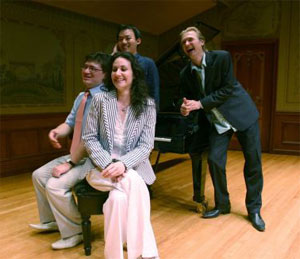by Daniel Hathaway

CIPC is open to pianists between the age of 18 and 30 by a certain cutoff date. Two years ago, Martina Filjak of Croatia and Dmitri Levkovich of Canada (pictured front and right) had both turned thirty when the contest began. Experience must count, as the two eventually won first and second place once all those thousands of notes had faded away.
Two years ago, the youngest pianist was 19. There were five 20-year olds, four each were 25 and 26, three each were 21, 22 and 24, and pairs of competitors were 23, 27, 28 and 29.
In 2011, sixteen pianists are at or above the median age of 25, and ten below (but no one younger than 21). Four pianists, having turned 30, are in this game for the last time.
This year’s contestants were born in ten different countries including China (5), Korea (5), the USA (4), Russia (3), Ukraine (3), Italy (2), Japan (2) and Germany, Latvia and the U.K. (one each).
That’s not to say that everybody has stayed put in his or her country of origin. Piano studies have lured many to the United States (including five Chinese, four Koreans, two Russians and one Ukrainian), and a few more to the U.K., Canada, Germany and Switzerland.
Whether they stuck close to home or ventured abroad, those twenty-six pianists have studied at forty-three different educational institutions all over the world. The USA is the frontrunner: nine have attended Juilliard, four each the Curtis Institute and the New England Conservatory, two the Manhattan School, and one each Azusa Pacific University, the Cleveland Institute of Music, the Longy School of Music, Northwestern University, the Peabody Conservatory, Rice University, Shenandoah University and the University of Minnesota.
Others have received their training at the Accademia Pianistica (Imola), the Accademia Santa Cecilia (Rome), Conservatory “Tito Schipa”, the Mendelssohn Piano Academy, the Pollini Conservatory (Padova) and the University of Padova in Italy; Cambridge University, the Royal Academy and Royal College of Music (London), the Royal Irish and Royal Scottish Academy in the U.K.; the Central Conservatory (Beijing) in China; the Conservatory for Highly Gifted Children, the Lysenko Music School and St. Petersburg Conservatory in Ukraine; Dresden and Würzburg Universities, and the Hochschulen of Frankfurt and Hannover in Germany; the National University of Arts, Seoul Arts High School and Seoul University in Korea; the Kazan State Conservatory in Tartarstan; the Latvian Academy of Music in Latvia, the Szymanowski Academy in Poland; the Zürich University of the Arts in Switzerland; Showa University and Tohogakuen School in Japan; and the Conservatory of Mount Royal University in Canada.
All but one of the contestants took music performance degrees — the exception being Daniele Rinaldo of Italy, who holds both a degree in composition and one in mathematical economics in addition to his piano studies.
As one would expect from a field of players distinguished enough to win a place in the Cleveland competition, none of the contestants is a complete newbie to the world of piano competitions. A glance at the artists’ profiles gives a good overview of the vastness of that international playing field — and promises ten days of remarkable piano playing in Cleveland over the next two weeks.
Click here to read Plain Dealer music critic Donald Rosenberg’s analysis of the repertory you’ll hear during the competition.
2009 finalists: photo by Sam Hubish.


